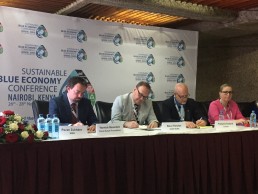NAIROBI – Placing a value on the oceans becomes a complicated task unless the motivations behind the questions are understood.
Discussing the true value of the ocean was one of the discussions at Sustainable Blue Economy Conference, in Nairobi, Kenya. It was titled ‘Value of the Ocean’, organised by the United Nations Environment, Fisheries and Oceans Canada, and the Swedish government.
Yannick Beaudoin, from the David Suzuki Foundation, said the system in which the world operates is one that largely concentrates or focuses on production of goods and services for benefits. Additional factors such as climate change, sustainability and other factors are not generally considered. He said society is driven by a primary force that asks “How do you quickly convert nature to some kind of financial wealth?”
He explained a theoretical model of Doughnut Economics by Kate Raworth an academic at Oxford University — the model name is also the title of a book by Raworth — who essentially says that “economics is broken” and in which she identifies 7 principles of economics that need to be updated as she says the current system of economics does not care about people or the environment.
“But [what if] if you started to plan your outcome first and then started backtracking on things that you actually need to make those decisions, rather than what is happening now,” he said.
He said that measuring data did not necessarily mean that it would lead to sustainable outcomes.
“If we look on land, we have measured a lot. Measuring has provided a lot of data. But not the decisions and the outcomes that we want. What are we saying we want? We say we want sustainable fish stock, sustainable forests but for 50 years we’ve seen that degradation. So we’re measuring it, we are somehow not translating that into a decision. And so then is it a technical impediment or is it something more social perhaps?”
Francois Soulard, chief of Statistics Canada, spoke on environmental accounting as a way of formulating an integrated approach and said it creates a good understanding of the relationship between the environment and society. He admitted that it was not enough and said he agrees with Beaudoin.
“To put it more bluntly here, we are guided by greed, instead of being guided by a light of utopia. And have to reflect on these things.”
He said Canada’s Fisheries and Oceans Department did a good job in putting together a marine economy snapshot.
He said that the total Marine Economy in Canada represented 1.8 percent of the country’s entire economy. He added that fish stocks, energy and other natural resources were not included in the marine economy and it needed to be taken into consideration that that had value for Canadians.
“We talk about valuing the ocean in this session. The first thing about valuing the ocean is to measure it in biophysical terms. If we don’t have those non-mortary valuation components, we cannot do the economic valuation components,” he said.
Soulard said the oceans needed to measured in terms of extent, condition, services and beneficiaries.
He said that while Canada was able to measure about half of the indicators for the SDGs overall, for SDG 14 the country was only able to measure just 20 percent. “And we consider ourselves a data-rich country.”
Chantalle Clarke-Samuels, from the Coastal Zone Management Authority in Belize, shared her country’s experience in applying ecosystem values in coastal decision-making and planning. She outlined a project that involved modelling and stakeholder participation and engagement, conducted with support from the World Wildlife Fund (WWF) and a national habitat project at Stanford University and approved in 2016.
She said the project recognised the need for co-ordinated, cross-sectorial planning efforts to safeguard the ecosystems that “contribute to the well-being of Belizean’s and supports the sustainable blue economy at a national level.”
She said when they started the planning process in 2010, it was at a time when the country’s marine environment had been zoned for potential future oil exploration. “But after looking at the potential impacts on habitats and ecosystem services and of course through strong advocacy and public support, that activity is no longer on the national sustainable development agenda for Belize.”
Clarke-Samuels said that during the initial engagement sessions with stakeholders, her planning agency asked coastal community members key questions on which sectors and which human users in the coastal zone required improvement or restoration and where should it be located in the future.
“They mentioned there were a variety of uses and benefits they enjoyed – they were able to make the link between those activities and how coastal and marine systems support them. Including as well the potential risks for certain activities on their livelihoods,” Clarke-Samuels said.
She said that through using an evaluation tool called Invest — the Integrated Evaluation of Ecosystem Services Tool — the Coastal Zone Management Authority was able to investigate and predict how human activities affect the flow of benefits from ecosystems to people and how to use the results of an ecosystem valuation to adjust where human activities could or could not occur to reduce risks to important ecosystems.
“We were able to evaluate the likelihood of changes in benefits flowing to people from reefs from sea grass and mangroves under three alternative management scenarios,” she explains.
She said they mapped 8 human use activities of in the marine area and from this was able to understand the cumulative effects from those activities, including understanding the amount of fisheries catch by pound.
“So in terms of lobster how would that increase or decrease based on the management scenario for the future. We were able to assess the likelihood of changes in the number of visitors to our shores and the number of people per annum as well as the expenditures that would be spent by tourists.
“In terms of protection of the coastline we were able to assess the amount of coastline and square kilometres that would be protected by having healthy reefs and mangroves in tact,” Clarke-Samuels explained.
Clarke-Samuels said that her organisation’s work in Belize “does serve as an example for how it is possible to account for nature, help people benefit and use that information to bridge the gap between science and policy and inform coastal management decisions.”
“The key message here is from Beliezes’s experience is that ecosystem services valuation can provide useful matrix for ocean and coastal planning. Specifically this approach allowed us to value ecosystem services in specific ways.”
Related Works
Nothing found.


